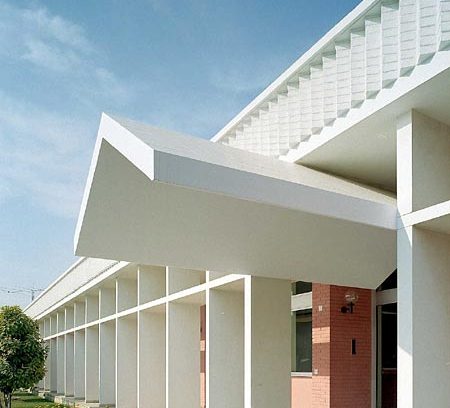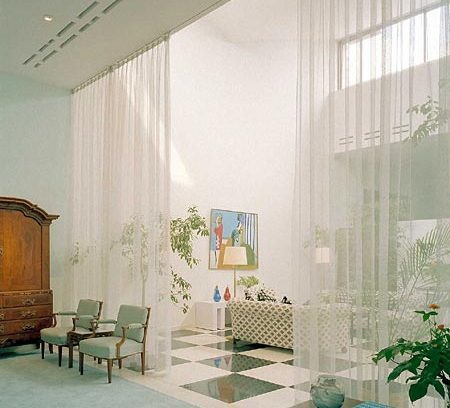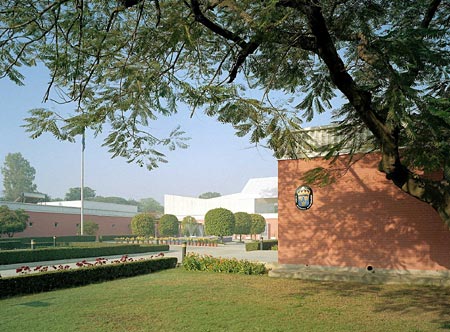This website uses cookies
This website uses cookies to enable it to function properly and to analyse how the website is used. Please click 'Close' to accept and continue using the website.






March 2006 - The Swedish Embassy, New Delhi
Text by Denise Hagströmer, pictures courtesy the Swedish National Property Board
Completed in 1959, this was Sweden’s first large-scale modern embassy compound. It was part of the new diplomatic enclave at Chana Kyapuri, New Delhi, and covered 40,000 square metres between the US and Soviet embassies. It was designed by architects Sune Lindström (1906-89) and Jöran Curman (1907-72). Lindström was a student of Gropius and Meyer at the Bauhaus, but is almost unresearched. His best-known building in Sweden is the Wenner-Gren Center, Stockholm’s first skyscraper, which is contemporaneous with New Delhi.
The entrance opens onto a courtyard, with the saddle-roofed State Reception building opposite linked by covered walkway to the Chancery and Ambassador’s residence to the right and left respectively. ‘Model homes’ were provided for the entire 80-100 embassy staff, from ambassador to chauffeur, gardener and domestics. The State Reception building is the only exception to a universal low-rise bungalow style with colonnaded arcades.
Swedish Arkitektur magazine provided much information on the architects’ objectives: to avoid pastiche, to draw on local architectural features such as pergolas and arcades. Prime concerns included construction techniques, the function of the buildings and irrigation for shade-giving shrubs and trees. The grounds were landscaped by Walter Bauer.
Danish interior architect Malene Björn designed interiors in collaboration with her husband, Sune Lindström. Prior to New Delhi, she had been commissioned by SAS (Scandinavian Airline Systems) to design the interior of their first passenger jet. Now in her 90s, she has also been overlooked by Scandinavian design history.
The result is high Scandinavian design at its very zenith. Architect designers included Josef Frank of Svenskt Tenn in Stockholm, Bruno Mathsson, Nisse Strinning, Eero Saarinen, Lars Ljunglöf and Hans Kempe. Today, the dining room is the best preserved of the rooms.
The first ambassador to move in was Alva Myrdal, a pioneering social democratic reformer widely regarded as one of the founders of the Swedish welfare state. She was Sweden’s first female ambassador and India’s first accredited female diplomat. Swedish embassies and residences have been the responsibility of the Swedish National Property Board since 1949, and prior to that, the Foreign Ministry. The Swedish government itself has only been involved in renting or building property abroad since the early 1900s. Previously, ambassadors were expected to make their own arrangements, using their own money.
During the last decades, the New Delhi compound has seen a number of extensions and renovations. These include extensions for Sweden’s international aid agency, SIDA, by architect Joe Lindström (Sune Lindström’s son) of VBB Architects, and most recently, the Swedish Trade Council by Pia Kjellgren Schönning and Joe Lindström of SWECO FFNS Architects. These additions, and landscaping by Bauer & Karon from Stockholm, have all sought to harmonise with the original buildings.
The Embassy at New Delhi manifests the meeting of, on the one hand, the Swedish national narrative of modernity, Folkhem (‘People’s Home’: political metaphor for society as family, where the well-off look after the less fortunate) with European-American Modernism; and on the other hand, the meeting of international ‘high politics’ with local mores.
Denise Hagströmer is an international design curator, writer, lecturer and consultant, currently researching a PhD at the RCA/V&A: In Search of a National Vision: Swedish Embassies from the mid-20th Century to the Present
Look for past Buildings of the Month by entering the name of an individual building or architect or browsing the drop down list.

Become a C20 member today and help save our modern design heritage.